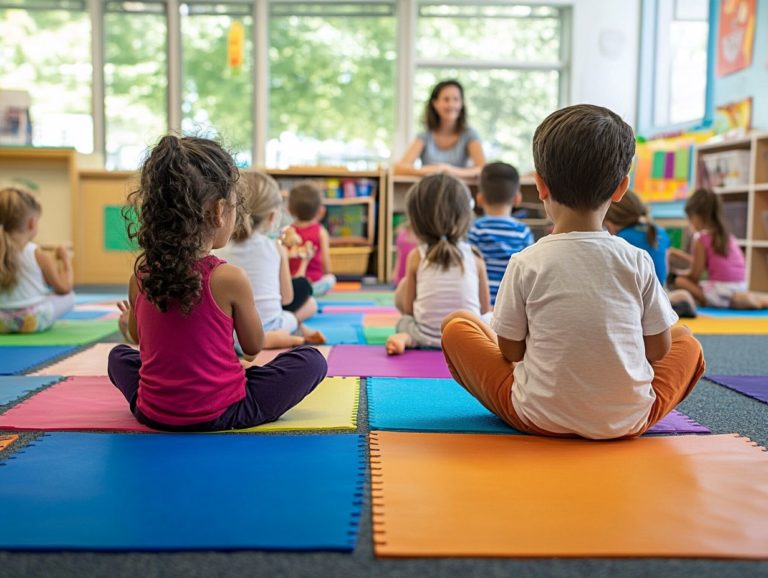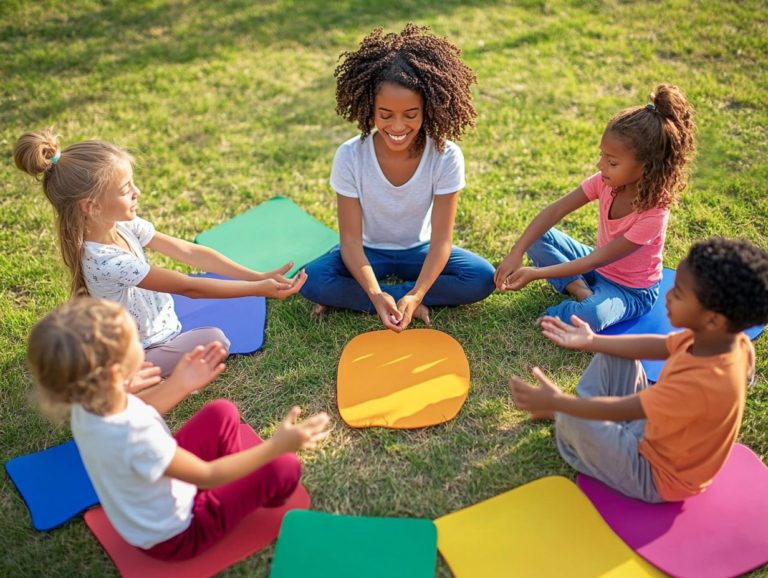7 Breathing Techniques for Family Calm
In today s chaotic world, families often struggle to find peaceful moments together. Fortunately, deep breathing techniques present a simple yet powerful solution to cultivate tranquility and strengthen your connections.
This article introduces you to seven effective methods designed to soothe stress and enhance your family’s well-being, including techniques like Square Breathing, Lion’s Breath, and the 4-7-8 breathing method. You ll uncover the numerous health benefits of these practices, learn how to seamlessly integrate them into your daily routine, and discover tips for engaging even the youngest members of your family in this essential self-care.
Embrace the journey toward a more peaceful family dynamic and unlock the transformative power of mindful breathing and integrative medicine.
Contents
- Key Takeaways:
- 1. Square Breathing
- 2. Belly Breathing
- 3. Alternate Nostril Breathing
- 4. Counted Breaths
- 5. Humming Bee Breath
- 6. Lion’s Breath
- 7. Progressive Muscle Relaxation
- How Can Breathing Techniques Help with Family Calm?
- Breathing Techniques: Unlocking Their Benefits
- How Can Breathing Techniques Help with Specific Family Situations?
- What Are Some Tips for Encouraging Children to Practice Breathing Techniques?
- Frequently Asked Questions
- What are 7 breathing techniques for family calm?
- How can deep belly breathing help my family stay calm?
- What is alternate nostril breathing and how does it promote calmness?
- How does lion’s breath benefit my family’s emotional well-being?
- Can humming bee breath be helpful for my family’s calmness?
- What is the 4-7-8 breathing technique and how does it benefit my family?
- How can guided imagery breathing help my family stay calm in stressful situations?
Key Takeaways:

- Incorporating breathing techniques into daily life can help families find calm, reduce stress, and offer significant anxiety relief.
- Some of the best times for families to practice breathing techniques together include before bed, during transitions, and during moments of conflict, utilizing methods like the Calm app for guided sessions.
- Teaching children and family members how to practice breathing techniques can benefit their mental and emotional well-being, enhance breath awareness, and improve overall family dynamics.
1. Square Breathing
Square breathing is a powerful mindfulness technique that invites you to inhale, hold, exhale, and pause for equal counts, creating a soothing rhythm that fosters calmness and clarity. This practice can significantly aid in relieving anxiety and enhancing your emotional well-being.
By focusing on your breath, you tap into the calming effects of square breathing, promoting a relaxation response that engages your parasympathetic nervous system. This engagement helps reduce stress and tension, ultimately contributing to your holistic health and mental clarity.
To practice square breathing effectively, simply take a deep breath in for a count of four, hold that breath for another count of four, exhale for four counts, and then pause for four counts before repeating the process. This structured approach helps clear your mind, allowing you to return to the present moment while releasing unnecessary tension and lightheadedness.
Incorporating square breathing into your daily routine can significantly diminish feelings of anxiety, offering you a simple yet effective tool for navigating stress.
As a fundamental component of breathwork and mindfulness, square breathing encourages you to connect more deeply with your body and mind, fostering a greater sense of peace and emotional balance.
2. Belly Breathing
Belly breathing, also known as diaphragmatic breathing, is an essential technique that enables you to fully engage your diaphragm, promoting deep, intentional breaths. This practice not only enhances relaxation but also offers a host of health benefits, contributing to both physical and mental well-being.
As you draw air deeply into your lungs and allow your abdomen to rise and fall, you maximize oxygen exchange and activate your parasympathetic nervous system. This system is your body s best ally in counteracting stress responses. When you focus on your breath, you may notice a significant reduction in muscle tension, leading to a profound sense of calm and body awareness.
This straightforward technique is particularly effective for managing daily stress, nurturing emotional balance, and even improving sleep quality. By calming your mind and body before bedtime, you set the stage for restful sleep.
With regular practice, you can transform the way you handle stressors, fostering resilience and embracing a more peaceful lifestyle. This form of breath practice is also highly beneficial for cognitive biases reduction and emotional regulation.
3. Alternate Nostril Breathing
Alternate nostril breathing, also known as Nadi Shodhana, is a technique from yoga. It allows you to alternate breaths through each nostril, contributing to balance, clarity, and emotional well-being. This practice serves as a calming distraction in stressful moments.
To begin, find a comfortable seated position with a straight spine. Use your right thumb to close the right nostril and inhale slowly through the left. Once you reach the peak of your inhale, open the right nostril while closing the left. Exhale through the right side.
Continue this rhythmic pattern to enhance your awareness of breath. It assists in regulating emotional arousal, reducing stress, and sharpening focus. This practice promotes relaxation and mental clarity, elevating your overall well-being. Practitioners like Th ch Nh t H nh emphasize the benefits of these techniques for achieving mindfulness.
4. Counted Breaths
Counted breaths involve a rhythmic breathing pattern where you consciously count each inhale and exhale. This fosters mindfulness and nurtures a sense of calm while managing stress and anxiety.
Create a personal counting sequence that feels comfortable maybe three counts for inhalation and exhalation or longer sequences of five or six. This practice aids in breath regulation, providing a soothing method to manage stress.
Incorporating this method may yield significant psychological benefits, such as reduced emotional arousal in stressful situations. Enhancing breath control can elevate self-awareness and emotional regulation, making it a powerful tool for maintaining mental well-being amidst daily challenges.
5. Humming Bee Breath

Humming bee breath, or Brahmari, combines deep inhalation with a soothing humming sound during exhalation. This practice enhances relaxation and mental clarity.
This technique engages a part of your body that manages stress and relaxation through its vibrational quality. By focusing on the hum, you can divert attention from daily stressors. It is often recommended for its calming effects in yoga and mindfulness practices.
To practice, find a comfortable position, inhale deeply through your nose, and exhale slowly while humming, like a gentle bee buzz. This mindful approach calms the mind and stimulates endorphin release, fostering emotional well-being.
Incorporating humming bee breath into your routine can be a powerful tool for stress reduction. It helps cultivate a deeper sense of tranquility and grounding amidst modern chaos.
6. Lion’s Breath
Lion’s breath is a dynamic breathing technique designed to encourage deep inhalation followed by an open-mouthed exhalation, reminiscent of a lion’s roar. This practice draws your attention to your breath, promoting awareness while facilitating emotional release and tension reduction.
It is a popular technique in yoga breathing and meditation for its effectiveness in emotional well-being. Engaging in lion’s breath fosters a sense of playful freedom and serves as a powerful antidote to stress and anxiety.
By tapping into the strength of your breath, you can cultivate a steadier state of mind that enhances your overall well-being. Exercises like this one are capable of releasing pent-up emotions and clearing mental clutter, paving the way for clarity and calm.
This technique is often highlighted in stress management workshops for its immediate benefits. Incorporating such practices into your daily routine can lead to profound transformation, encouraging both physical relaxation and emotional resilience qualities that are essential for thriving in today s fast-paced world.
7. Progressive Muscle Relaxation
Progressive muscle relaxation is a highly effective technique that invites you to sequentially tense and relax your muscle groups. This process enables you to cultivate greater body awareness and achieve a deep relaxation response that beautifully counters stress and tension.
This method guides you to systematically focus on different muscle sets, opening pathways to release the physical signs of stress and promoting a profound sense of tranquility. As the tension begins to melt away, you may notice a significant reduction in your heart rate and blood pressure, contributing to an overall state of calm.
When you pair this technique with breath exercises, the benefits of progressive muscle relaxation become even more pronounced. Controlled breathing enhances oxygen flow, further amplifying your body s capacity to release stress.
This holistic approach nurtures resilience, making it an essential strategy for anyone seeking comprehensive methods for effective stress management. Experts at the Cleveland Clinic recommend this practice for its comprehensive health benefits.
How Can Breathing Techniques Help with Family Calm?
Looking to bring more calm into your family life? Breathing techniques can significantly enhance the calm within your family, fostering emotional well-being, promoting mindfulness, and providing effective strategies for stress reduction.
This creates a harmonious environment where each family member feels supported and understood, especially during challenging times. By incorporating yoga breathing and other breath techniques, families can build a foundation of emotional trust and support.
By incorporating specific breathing exercises into your daily routines, you can cultivate a deeper sense of connection among family members. Simple practices, such as deep belly breathing or the 4-7-8 method, can be introduced in a fun and engaging way, making them accessible for all ages.
These techniques not only help you regain composure during moments of anxiety or frustration but also encourage open communication, allowing everyone to share their feelings more freely.
Over time, these shared experiences foster trust and understanding, strengthening the emotional bonds that keep your family united. Start these breathing exercises today to transform your family dynamics!
Breathing Techniques: Unlocking Their Benefits
What Are the Benefits of Practicing Breathing Techniques?
Practicing breathing techniques offers you a wealth of benefits, from improved health and enhanced mental clarity to reduced anxiety levels and increased emotional well-being. Incorporating these techniques into your personal wellness routine can be truly transformative.
Research has shown that controlled breathing can alter your body’s stress response. It effectively lowers cortisol levels, which contribute to anxiety and tension.
When you engage in these techniques, you activate your parasympathetic nervous system, which promotes relaxation and instills a deep sense of calm.
This physiological response helps you mitigate stress and enhances your cognitive function, leading to clearer thinking and better decision-making.
You’ll find that these practices foster a stronger connection between your mind and body. This leads to improved emotional regulation and greater resilience when facing daily challenges.
Such compelling scientific evidence highlights the essential role that breathing techniques play in cultivating a balanced emotional and mental landscape.
How Can Breathing Techniques Be Incorporated into Daily Life?

Incorporating breathing techniques into your daily life is entirely achievable through intentional breathwork, simple mindfulness practices, and dedicating moments throughout the day to enhance your breath focus. Start today and cultivate a calmer, centered life!
These techniques are adaptable and readily accessible, allowing you to seamlessly integrate them into your various routines.
For example, during a hectic workday, you can take a brief pause to practice deep belly breathing, which helps you relax and focus better. This not only helps stress dissipate but also boosts your focus and productivity.
As a parent, you can engage in quick breath awareness exercises while attending to your children, fostering a sense of calm for both yourself and your little ones. Even during leisure time, like a peaceful evening at home, dedicating just a few minutes to deep breathing can enhance relaxation and mindfulness. This illustrates how integrating breathwork into life s moments can lead to profound benefits.
What Are the Best Times to Practice Breathing Techniques as a Family?
The best times to practice breathing techniques as a family are during stressful events, bedtime routines, and shared moments of reflection. This approach allows you and your loved ones to collectively access a relaxation response that enhances emotional well-being.
Imagine a hectic school morning. Just taking a few moments to breathe deeply together can help everyone regain focus and calmness before the day begins.
Incorporating breathing exercises into your bedtime routines doesn t just help you wind down; it creates a comforting atmosphere that improves sleep quality for both children and parents.
During family gatherings or conversations about challenging topics, practicing coordinated breathing can foster a sense of unity and support, making it easier for everyone to communicate openly and embrace shared emotions. This simple yet powerful practice strengthens connections and builds resilience within the family, especially in today s fast-paced world.
How Can Breathing Techniques Help with Specific Family Situations?
Breathing techniques can be customized to assist you and your family in navigating specific situations, whether it s managing anxiety during school transitions or handling stress at family gatherings. These methods ultimately promote healthier family dynamics.
During the often chaotic school transition period, practice deep belly breathing together as a family. This simple act allows children to feel more grounded and confident.
At family gatherings where emotions might run high, consider employing the 4-7-8 breathing exercise. This technique helps dissipate stress and creates a shared moment of tranquility, fostering a more pleasant atmosphere for everyone.
In times of emotional disagreement, using a technique called box breathing can help family members regain their composure. This approach assists in helping to achieve more thoughtful responses and improved communication.
Integrating these practices into your daily routines can significantly enhance emotional regulation and understanding among all family members.
What Are Some Tips for Encouraging Children to Practice Breathing Techniques?
Encouraging children to practice breathing techniques can be a delightful journey. Incorporate engaging activities, playful demonstrations, and elements of mindfulness that resonate with their interests to nurture their emotional well-being.
Integrate fun games and creative storytelling into your routine to make these techniques appealing. For instance, try a simple balloon-blowing activity. This not only demonstrates deep breathing but also adds a playful twist that effortlessly captures their attention.
Family yoga sessions can create a warm atmosphere where mindfulness becomes a joyful group activity. For younger children, activities like “bubble breathing” where they imagine blowing bubbles while taking deep breaths can be especially captivating. These age-appropriate strategies help them grasp the importance of breathing exercises in a natural and enjoyable way.
Frequently Asked Questions
What are 7 breathing techniques for family calm?

The 7 breathing techniques for family calm are deep belly breathing, alternate nostril breathing, lion’s breath, humming bee breath, equal breathing, 4-7-8 breathing, and guided imagery breathing.
How can deep belly breathing help my family stay calm?
Deep belly breathing involves taking slow, deep breaths using your diaphragm. This can help reduce stress and anxiety while increasing feelings of calm and relaxation for your whole family.
What is alternate nostril breathing and how does it promote calmness?
Alternate nostril breathing is a technique where you inhale through one nostril, hold the breath, and then exhale through the other nostril. This technique can help balance the left and right sides of the brain, promoting calmness and focus.
How does lion’s breath benefit my family’s emotional well-being?
Lion’s breath involves taking a deep inhale through the nose and then forcefully exhaling through the mouth while making a “roaring” sound. This can help release pent-up emotions, reduce tension in the face and throat, and promote feelings of calmness.
Can humming bee breath be helpful for my family’s calmness?
Humming bee breath, also known as Bhramari pranayama, involves inhaling through the nose and then exhaling while making a humming sound. This can soothe the nervous system and help calm the mind and body.
What is the 4-7-8 breathing technique and how does it benefit my family?
The 4-7-8 breathing technique involves inhaling for 4 seconds, holding the breath for 7 seconds, and then exhaling for 8 seconds. This can help regulate the nervous system, reduce stress, and promote feelings of calmness and relaxation.
How can guided imagery breathing help my family stay calm in stressful situations?
Guided imagery breathing involves focusing on a calming image or scenario while taking slow, deep breaths. This can help your family relax and reduce feelings of stress and anxiety in challenging situations.
Start today and discover how these practices can enhance your family s happiness!






